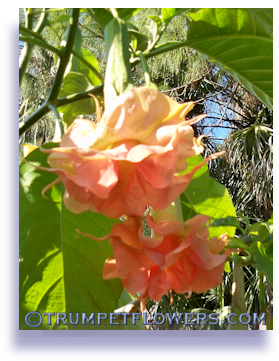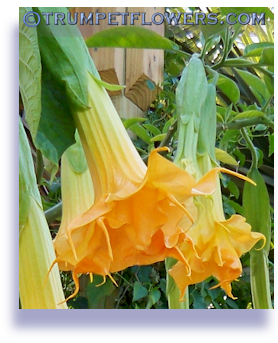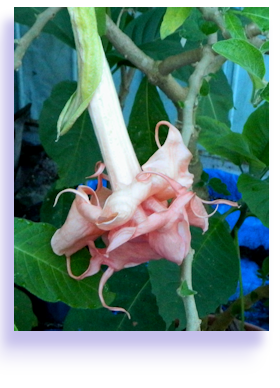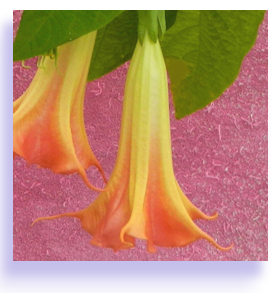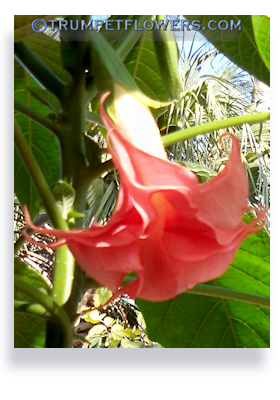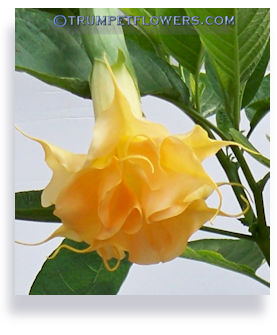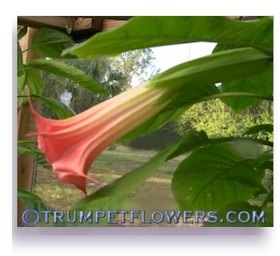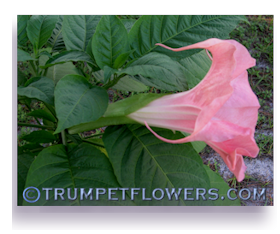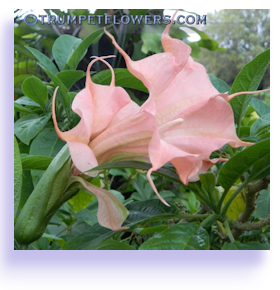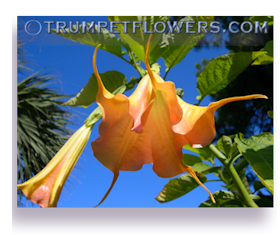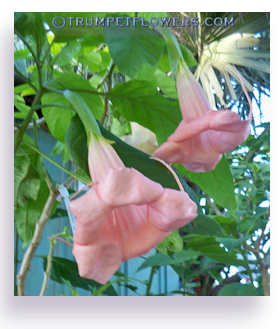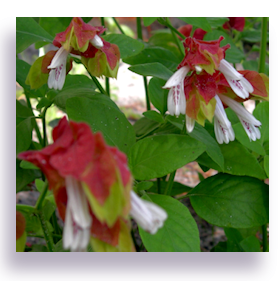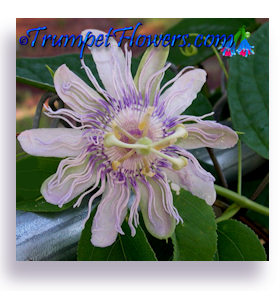Stem Cuttings
For Propagation
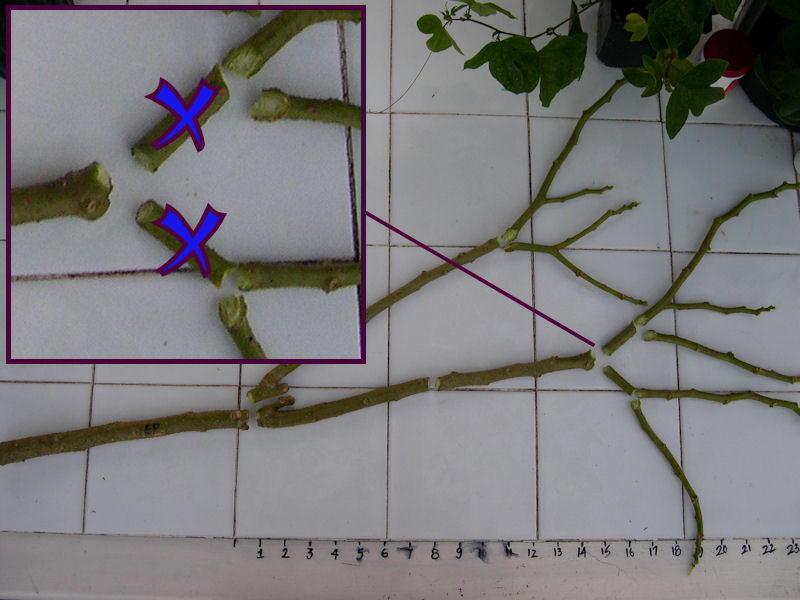 ◄ Click photo for enlarged view. There are particular ways that you must cut any plant if you want to succeed at propagating it. Some plants are better at being made into propagation cuttings than others. Trial and error will show you this. But here I will show you the right way to cut up a trumpet flower branch or stem for reproductive/propagation purposes. The technique I am showing you is proper for all types of plant species or cultivar cuttings, should they be the type that can be propagated from stem cuttings. I use brugmansia because it is my favorite plant.
◄ Click photo for enlarged view. There are particular ways that you must cut any plant if you want to succeed at propagating it. Some plants are better at being made into propagation cuttings than others. Trial and error will show you this. But here I will show you the right way to cut up a trumpet flower branch or stem for reproductive/propagation purposes. The technique I am showing you is proper for all types of plant species or cultivar cuttings, should they be the type that can be propagated from stem cuttings. I use brugmansia because it is my favorite plant.
If you'd like to begin the process of making some more Angel Trumpets, or Brugmansia, here is how to cut up the upper stems to propagate them. I say upper stems, or branches, because cutting an Angel trumpet below the Y can curtail blooms. When Pruning a brugmansia, always take into account it's future growth, and what your end result will be. What do you want it to look like? Are your pruning to take inside for the winter, or are you taking cuttings for propagation? Is shape important to you? Think of all of these things before cutting on an Angel Trumpet flower tree.
I'm going to approach this conversation as though you know nothing of propagation, nor the terms or means to do this. Remember too, that most trees, especially those that are woody in nature, do not make good stem cutting material. There are exceptions though. But thankfully, trumpet flowers do make excellent stem cuttings, and future baby brugmansia.
Angel Trumpet trees do best for reproduction with semi-green to 'hardwood.' Angel trumpets, if you have a big one, and grasp the trunk or branch with any force, have a kind of 'give', or bend, to the wood. Remind me of Moringa, but with more solidarity. They are not solid wood trees. It takes many years for this plant to harden up in trunk and stem, a benefit to winds, but to the person cultivating it, human intervention/pruning will make a better looking tree. My own have withstood many tropical storm force winds, bending and giving in the winds, with little damage other than leaves and a few fragile new growth stem snap. These will root easily, if you take the time to learn more about this mysterious and beautiful plant.
 With Brugmansia, stem cuttings are the only way you can get them to come true from cultivar. Brugmansias are clones, never coming true from seed. So if you want another say, Langenbusher Garten, you'll have to own Langenbuscher Garten or know someone who does. Brugmansia cultivars are then cloned through stem cuttings.
With Brugmansia, stem cuttings are the only way you can get them to come true from cultivar. Brugmansias are clones, never coming true from seed. So if you want another say, Langenbusher Garten, you'll have to own Langenbuscher Garten or know someone who does. Brugmansia cultivars are then cloned through stem cuttings.
In the first photo, notice the two blue X's. Those are two pieces, when the stem has been properly cut into proper pieces, that are not useable. You must start your cuts just under a node. The top cut should also end just above a node, as these are place where the plant will send out new stems and leaves. Roots will spring from the node at the bottom, the end that will be place in the soil or perlite. Also, do not give each cutting just one node at the top and one on the bottom. You will have a better success rate if you make the cuttings longer, with a total of at least 3 to 5 nodes. I try to cut 5, if the stem is hardened enough. That means inbetween brown and green. Too much green and it could die. Brown green (semi-ripe) is just right.
Back to the nodes and why we cut just under one at base. If you left the middle of the stem, which has no nodes, it will rot in the soil or water you are placing it in, because it will not readily create roots on this plant cell material.
Click photo for enlarged view. ► 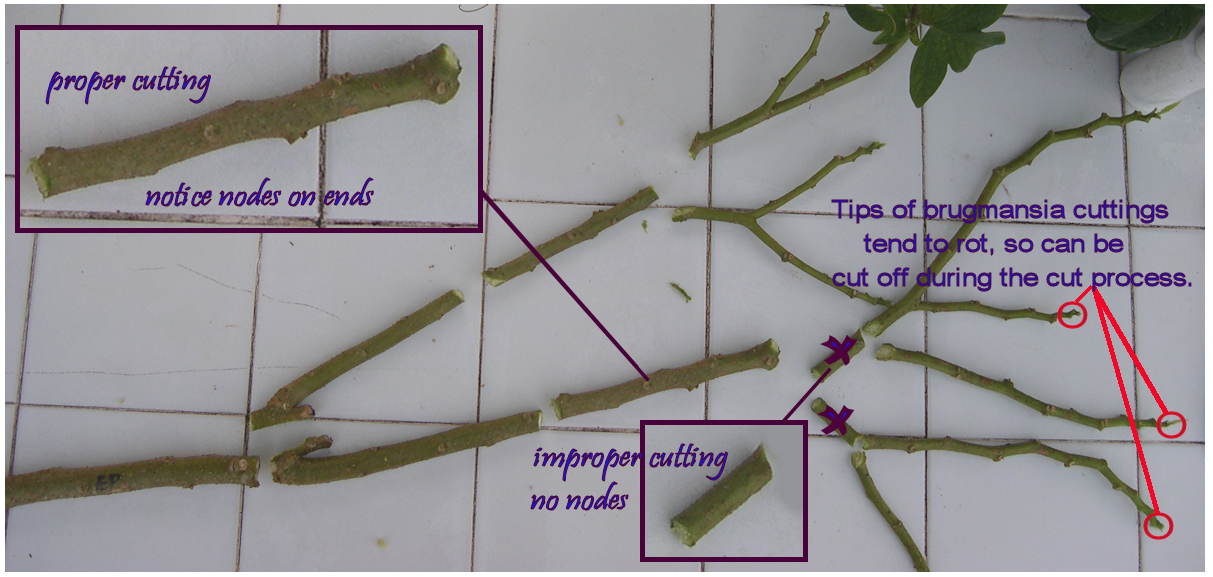 Plants have the wonderful ability of doing this because at the site of nodes, are plant cells can act very similar to human stem cells. That means these special cells have the ability to change into whatever the plant needs them to become. That could be roots, stems, or leaves, flowers, panicles, etc.
Plants have the wonderful ability of doing this because at the site of nodes, are plant cells can act very similar to human stem cells. That means these special cells have the ability to change into whatever the plant needs them to become. That could be roots, stems, or leaves, flowers, panicles, etc.
That is also why some plants are harder to reproduce from cuttings than others. They may have less of these special cells, or depending upon the specie, lack them entirely. That is why nurserymen have developed so many different ways to propagate plants, not just from stem cuttings.
The second photo above is much more detailed and will show you how to cut up an entire stem. It will show you where to cut, how many pieces are good, and which ones will be of no use to you.
By the way, on my explanation on the photo, I have called them 'improper cutting.' Actually, the stem is cut up the right way, and those two pieces would be remaining anyway. I just call them improper so you get the idea that they cannot be used for propagation. There are no plant hormone rich nodes on them, that could potentially create roots and stems during propagation. Since the softer, green growing wood on brugmansia tends to rot (the tips) cut this back before potting them up.
 Always use a sharp, clean and sterile set of pruners to do the cutting. To sterilize, use rubbing alcohol to the blades.
Always use a sharp, clean and sterile set of pruners to do the cutting. To sterilize, use rubbing alcohol to the blades.
Make sure that you either leave the pieces pointing all in one direction, or mark them beforehand with a permanent marker as to which way is up. You do not want to place the leafy end of the cutting in the soil!
◄ Notice the blue lines in photo to left showing you how to recognize 'right side up' cutting. Brugmansia nodes always cup in this manner when pointing in right planting direction. If you accidentally drop them, being able to determine this shape will enable you to properly place them in soil for rooting.
Rooting them up
When you are finished, dip the end that you will want to make roots into a solo cup of diluted molasses and water, and then into a rooting hormone powder. Make a hole in a small planter of soil, and place the cutting gently into it. Now carefully fill the soil in around the cutting and water very lightly. Keep it in a shady area for the first few weeks, until you begin to notice top growth. Keep the soil barely moist, but do not over water it, lest the cutting will rot underground. You can add some weak liquid fertilizer and Superthrive to the watering can when you do water the cuttings. This will help it get going.
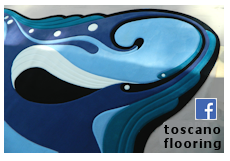 You can also use the water and peroxide method, pure perlite that is kept dampened, or a seedling mixture, for your cuttings. Compost is really not used very much when trying to root cuttings, as it is too heavy. If you do want to add compost, do it sparingly. Unmilled sphagnum moss is also excellent to use as a suspension material.
You can also use the water and peroxide method, pure perlite that is kept dampened, or a seedling mixture, for your cuttings. Compost is really not used very much when trying to root cuttings, as it is too heavy. If you do want to add compost, do it sparingly. Unmilled sphagnum moss is also excellent to use as a suspension material.
Make your own brugmansia cuttings mix or potting soil by reading this page: Soilless Mixes DIY. These work great for brugmansia.

Now that you know how to take stem cuttings, there is also another way you can attempt rooting them up other than the soil method above. If you'd like to try your hand at rooting some up using water and peroxide, read this page: Stem Cutting Propagation with Water amd Peroxide.Hard to root cuttings? Try rooting with eggs. Yes, raw chicken eggs! Pretty neat! Rooting cuttings with Chicken Eggs.And here is a page I just wrote, on just basically rooting up cuttings that you either take or receive from me: Propagate your stem cuttings.
 If you have access to it, pure rain water will get your cuttings to root faster than any other water type I've ever used. Same with seeds.
If you have access to it, pure rain water will get your cuttings to root faster than any other water type I've ever used. Same with seeds.
Tags: how to properly take stem cuttings,, stem cuttings, propagation from stem cuttings, proper stem cuttings, proper stem cuttings, propagate stem cuttings, propagate your brugmansia,

